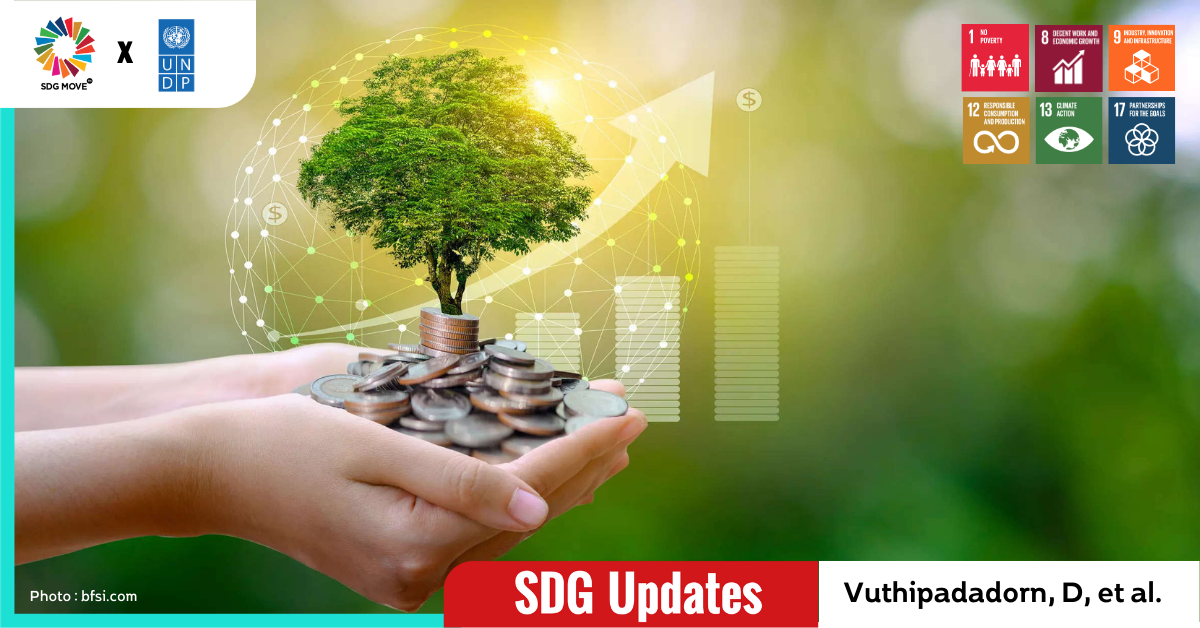Dadanee Vuthipadadorn
Anuk Serechetapongse
Aphinya Siranart
Thanawat Wachiratongkum
How can sustainable finance better support the country’s path towards sustainable human development and the achievement of the SDGs?
This is an important question for countries around the world, including Thailand, particularly amid multiple crises, from the pandemic to climate change and global geopolitical conflicts, that have hindered the progress towards the SDGs. The repercussions from these crises emphasize more than ever the urgent need and opportunity to put in place a more fit-for-purpose financing framework that synergizes both public and private finance to ensure SDG achievement by 2030.
COVID-19 represents an unprecedented global human development crisis that affects every aspect of lives and social and economic activities. It is superimposed on unresolved tensions between people and the planet, and between the haves and the have-nots, disrupting progress toward the county’s achievement of the Sustainable Development Goals (SDGs). The reality of climate change manifests in an increased volatility of weather events reflected in the loss of over 475,000 lives worldwide with US$ 2.56 trillion (in PPP term) as a direct result of extreme weather events during 2000-2019 [1] (Germanwatch’s Global Climate Risk Index, 2021). Developing countries are particularly affected by the impacts of climate change as they are more vulnerable to the damaging effects of a hazard and have lower coping capacity. Further, the ongoing war in Ukraine, along with sanctions imposed on Russia, creates yet another major shock to the global economy via supply chain disruptions, the rise in energy and food prices, the slowdown in international trade and tourism, and heightened volatility in the financial markets.
With the COVID-19 pandemic, Thailand’s GDP fell by 6.2% in 2020, before growing by only 1.6% in 2021. Despite Thailand’s marked progress in controlling the outbreak, the socioeconomic effects of COVID-19 are severe, as exports of goods and services account for about 70% of GDP with international tourism contributing 12% – 15% to GDP. Among the hardest hit were 20.36 million informal workers accounting for 53.7% of total employment[2]and women employed in the worst-hit sectors such as tourism. The country’s GDP growth estimation in 2022 is trimmed from 3.5 – 4.5%[3] to 3.2%[4] as the impact of the war is felt through the increase in the costs of living and exports is affected by the slower-than-expected global economy. The GDP growth for 2023 is projected to remain within the range of 3-4%[5].

It is undeniable that these multiple crises hinder the SDG progress around the world, including in Thailand. According to the Sustainable Development Report 2022, Thailand ranks 44th among 163 countries worldwide and 1st in the East and South Asia region on the progress towards SDGs. —with a score of 74.1, higher than the regional average score of 65.9.[6]However, there is little progress in reducing inequality, supporting good health and well-being, and proving affordable and clean energy. Major challenges are presented in the goals related to zero hunger, good health and well-being, life below water, life on land, and peace, justice and strong institutions. Thailand is cited as one of the ten most flood-affected countries globally and is ranked ninth on the list of the top ten countries most affected by climate change from 2000 – 2019 by Germanwatch’s Global Climate Risk Index 2021, with a significant risk that the poorest and marginalized groups will experience disproportionately greater loss and damage. It is evident that efforts to tackle climate and environmental challenges need to be strengthened to stimulate the progress.
Beyond the pandemic, climate, and geopolitical crises, Thailand is one of the fastest-ageing countries in the world, given a low birth rate and increasing longevity of elder groups. The number of people aged 60 and over in Thailand now stands at about 13 million, accounting for 20% of the population. By 2050, Thailand’s aging population is expected to increase to 20 million, accounting for 35.8% of the population.[7] This poses greater health risks and will increase healthcare burdens on the government going forward.
Whilst the multiple global and domestic crises pose significant challenges to Thailand, they also represent an opportunity for the country to revisit its growth and development pathway as well as to reformulate its financing strategy to foster resilient, inclusive, and SDG-aligned development. This points to an urgent need to step up the role of financing as a key enabler to secure sufficient resources for safeguarding the country’s SDG progress.
Thailand has made significant efforts in building forward better. During the pandemic, the Thai government launched a swift and comprehensive THB 1.9 trillion ($58 billion) stimulus package directed toward social protection and economic rehabilitation and an additional THB 500 billion (US$ 15 billion) loan for further economic and social recovery support. The public debt ceiling was raised from 60% to 70% of GDP to provide flexibility in policy implementation to tackle the pandemic and support the economic recovery.
The country follows the development pathway stipulated in the National Strategy (2018 – 2037) which emphasizes Thailand’s vision of “becoming a developed country with security, prosperity, and sustainability in accordance with the Sufficiency Economy Philosophy”. The upcoming 13th National Economic and Social Development Plan (2023 – 2027) will prioritize achieving high-value eco-friendly economy, society of opportunities and equality, sustainable way of life, and strengthening enabling factors for transformation. In COP27, Thailand reiterated its pledge to reach carbon neutrality by 2050 and net zero greenhouse gas emissions by 2065. As the 2022 APEC chair, Thailand emphasized the Bio-Circular-Green Economic (BCG) approach to promote green and inclusive growth, which became part of the Bangkok Goals endorsed by APEC members.
Despite multiple crises facing the country, Thailand’s credit rating remains intact. Recently, Moody’s maintained Thailand’s credit rating at Baa1 – the same score as the previous year, owing to the country’s continued economic growth trajectory, its robust financial sector, and its prudent public finance management.[8] This reflects that Thailand has a solid foundation for attracting investment from both domestic and international investors.

To enhance the role of financing in supporting sustainable development, the Sustainable Finance Initiatives for Thailand were formulated, under which green, social and sustainability bonds and loans are issued. The proceeds are used to finance and refinance existing and future government loans or expenditures in the form of direct investment expenditures, subsidies, fiscal measures and operational expenditures. The Public Debt Management Office launched Thailand’s inaugural sustainability bond in 2020 to promote growth of the environmental, social and governance (ESG) bond market in order to ensure that the Thai local bond market can become another driving force in tackling climate change and social issues. Currently, the market currently consists of THB 229.9 billion (US$ 6.7 billion) of ESG government and State Own Enterprise (Guaranteed) bonds (i.e., Sustainable bonds, Green bonds, Social bonds, and Sustainability linked bonds). Also, there has been an increasing interest in the issuance of ESG bonds in the private sector with a total bond outstanding of 118.6 billion baht (US$ 3.4 billion).[9]
Still, more needs to be done to galvanize resources necessary to support the country’s SDG achievement. Before the pandemic, UNESCAP (2019) estimated that, for Thailand to meet the SDGs, it will require around THB 1.27 trillion (US$ 40.9 billion) in additional annual investment from 2020 to 2030, equivalent to 50 baht per person per day. The estimate consists of investments in people (THB 513.5 billion or US$ 16.6 billion), prosperity (THB 426.1 billion or US$ 13.7 billion) and planet (THB 327.8 billion or US$ 10.6 billion)[10]. With the pandemic, the socio-economic and geopolitical challenges, and mounting climate and environmental risks, such additional investment needs to achieve the SDGs will be larger. On the other hand, Thailand’s tax to GDP ratio was 17.2% in 2019, below the Asia and Pacific average of 21.0%, and below the OECD average (33.8%). From 2007 to 2019, the tax to GDP ratio in Thailand decreased by 0.3 percentage points from 17.6% to 17.2%.[11] These figures indicate the urgent need for the country to not only enhance its public finance mobilization but to also increase the role of private finance to improve the overall management of available resources and mobilize additional resources to finance SDG-aligned priorities at national and subnational levels.
To strengthen development finance for sustainable development, 3 key areas need to be addressed.
First, Thailand needs to put in place a comprehensive and fit-for-purpose financing framework that synergizes public and private finance to support the country’s SDG advancement. UNDP is assisting the Ministry of Finance and the National Economic and Social Development Council (NESDC) in formulating an Integrated National Financing Framework (INFF) a tool to support the country in overcoming existing impediments to financing the country’s sustainable development agenda, including those identified in the 13th National Economic and Social Development Plan (2023-2027). It lays out the full range of financing sources–looking at better alignment between financing and national objectives, at how fiscal space and policy options can better finance priority initiatives, and how to channel private sector resources towards building forward better, to contribute to a more inclusive and green development pathway. As a first step, UNDP is undertaking a Development Finance Assessment (DFA), which identifies the country’s financing needs for development, including in 5 thematic priorities: tackling climate and environmental challenges, promoting equality, health sector, job protection and creation, and advancing digital finance for sustainable development. The outcome of the assessment will form the basis of a financing strategy, which will synergize a wide range of tools—from tax and budget to public debt, incentives, and other financial instruments—and leverage different types of financing to achieve greater impact. With a holistic financing strategy, the INFF will ultimately serve as a platform for policymakers, the private sector—domestic and international, and other development actors to, together, unlock new and innovative financing solutions both at national and subnational levels, bringing SDG-aligned investment to scale.
Second, Thailand needs to better leverage private sector finance through the identification of SDG-aligned viable investment opportunities. UNDP is partnering with the Securities and Exchange Commission in conducting the SDG Investment Opportunities mapping exercise for Thailand, building on the momentum of the private sector in contributing to SDG progress. The SDG Investor Map is an innovative tool that will help facilitate private investments for the SDGs by providing localized insights into investment opportunity areas where financial return and impact potential to advance the SDGs coalesce. This initiative will enable private investors to be equipped with insights on investment opportunity areas (IOAs) or investable solutions to pressing development needs. The Map identified 15 Investment Opportunity Areas (IOAs) across eight sectors, namely food and beverages, renewable resources and alternative energy, health services, transportation, financials, infrastructure, services and education. This will help Thailand in attracting the much-needed investment from the private sector on its sustainable development agenda.
Third, Thailand needs to develop a holistic risk financing strategy to effectively manage the impacts of climate change and disaster risks. Given greater risks and uncertainties surrounding the country, risk management and risk finance should be an integral part of Thailand’s financing framework. Within the framework of the Tripartite Agreement between UNDP, the Insurance Development Forum (IDF) and the German government, UNDP has conducted a diagnostic study on inclusive insurance and risk finance for Thailand. The diagnostic report emphasizes the need for a comprehensive financing framework to promote inclusive insurance and national disaster risk financing strategies to support the different phases of disaster risk management. It also identifies potential interventions and support required to create an enabling environment and facilitate market development for inclusive insurance and risk finance in Thailand and indicates opportunities to integrate risk transfer instruments such as insurance into ex-ante and ex-post risk financing. This will help mitigate the impact of risks on people, particularly the poor and most vulnerable populations who are often hit the hardest, upholding the Leave No One Behind principle.
Addressing sustainable development finance amid multiple crisesis challenging as the pathway to achieving resilient, inclusive, and SDG-aligned recovery is not always linear when considering the dynamics and dimensions of the socioeconomic and environmental changes across periods. There is no silver bullet to tackle these crises, and concerted implementation of multiple policy options is needed. The INFF will serve as a framework that will improve the coherence between planning and financing, presenting a menu of policy options to realign and mobilize public and private finance. The SDG investor map will identify viable opportunities for SDG-aligned private investment and further unlock private finance for pressing development needs. This will be complemented by the inclusive insurance and risk finance initiative which would provide needs-based risk finance solutions for the country to weather the storms coming its way. Together, these tools have enormous potential for a catalytic shift in redirecting resources to more useful purposes, freeing up resources for development that are tied up elsewhere, and mobilizing new resources to maximize the chance of Thailand meeting the SDGs. This is the time for reshaping financing policies and frameworks and rethinking development pathways for a resilient, inclusive, and sustainable recovery particularly in the midst of crises, conflicts, and beyond.
Dadanee Vuthipadadorn (CO Chief Economist), Anuk Serechetapongse (CO Economist), Aphinya Siranart (Head of Exploration), and Thanawat Wachiratongkum (Research Assistant), UNDP Thailand
This article relevant to;
#SDG1 no poverty
– (1.3) Implement nationally appropriate social protection systems and measures for all, including floors, and by 2030 achieve substantial coverage of the poor and the vulnerable
#SDG8 decent work and economic growth
– (8.4) Improve progressively, through 2030, global resource efficiency in consumption and production and endeavour to decouple economic growth from environmental degradation, in accordance with the 10-Year Framework of Programmes on Sustainable Consumption and Production, with developed countries taking the lead
#SDG9 industry, innovation and infrastructure
– (9.4) By 2030, upgrade infrastructure and retrofit industries to make them sustainable, with increased resource-use efficiency and greater adoption of clean and environmentally sound technologies and industrial processes, with all countries taking action in accordance with their respective capabilities
#SDG12 responsible consumption and production
– (12.6) encourage companies, especially large and transnational companies, to adopt sustainable practices and to integrate sustainability information into their reporting cycle
#SDG13 climate action
– (13.2) Integrate climate change measures into national policies, strategies and planning
#SDG17 partnerships for the goals
– (17.1) Strengthen domestic resource mobilization, including through international support to developing countries, to improve domestic capacity for tax and other revenue collection
– (17.2) Developed countries to implement fully their official development assistance commitments, including the commitment by many developed countries to achieve the target of 0.7 per cent of ODA/GNI to developing countries and 0.15 to 0.20 per cent of ODA/GNI to least developed countries; ODA providers are encouraged to consider setting a target to provide at least 0.20 per cent of ODA/GNI to least developed countries
– (17.3) Mobilize additional financial resources for developing countries from multiple sources
– (17.5) Adopt and implement investment promotion regimes for least developed countries
[1] Contrary to previous years, the underlying database for the calculation of the Climate Risk Index 2021 does not include data for the United States of America.
[2] National Statistical Office, 2020. The Informal Employment Survey 2020.
[3] NESDC Economic Report: Thai Economic Performance in Q1/2022 and Outlook for 2022 (May 2022) https://www.nesdc.go.th/nesdb_en/article_attach/article_file_20220517085428.pdf
[4] NESDC Economic Report: Thai Economic Performance in Q3/2022 and Outlook for 2022-2023 (November 2022)
article_file_20221121085936.pdf (nesdc.go.th)
[5] NESDC Economic Report: Thai Economic Performance in Q3/2022 and Outlook for 2022-2023 (November 2022)
[6] https://s3.amazonaws.com/sustainabledevelopment.report/2022/2022-sustainable-development-report.pdf
[7] https://www.eria.org/publications/population-ageing-in-thailand/
[8] Moody’s Maintains Thailand’s Credit Rating at Baa1 (prd.go.th)
[9] http://www.Thaibma.or.th/EN/Bandinfo/ESG.aspx
[10] The exchange rate used for currency conversion is 31 baht per US dollar, given that the year of calculation was in 2019. https://www.oecd.org/tax/tax-policy/revenue-statistics-asia-and-pacific-thailand.pdf
[11] In the OECD classification the term “taxes” is confined to compulsory unrequited payments to general government. Taxes are unrequited in the sense that benefits provided by government to taxpayers are not normally in proportion to their payments.http://www.oecd.org/tax/tax-policy/oecd-classification-taxes-interpretative-guide.pdf
Praewpan Sirilurt, copyreader
Pimnara Intaprasert, editor












